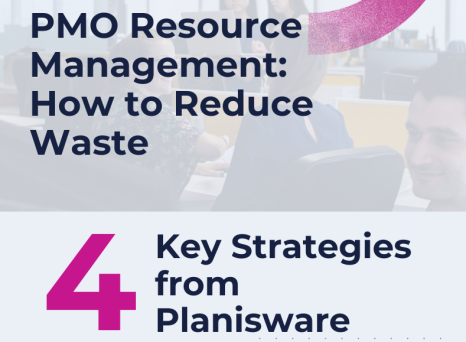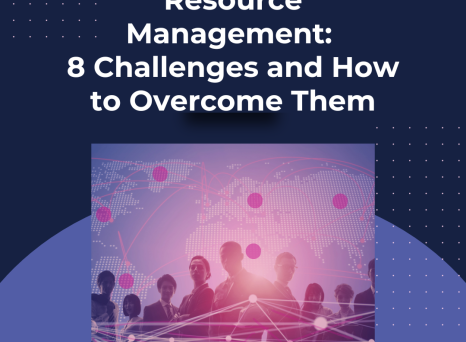Executive leaders, clients, and other stakeholders consistently expect project professionals to do more with less—or to deliver better results while using the same resources. Whether it’s people, time, or money, optimizing resource management is key to achieving project success.
At the heart of resource optimization is resource allocation, which involves the strategic assignment of human capital, financial resources, equipment, and time to project tasks.
That said, it’s far from simple. While the idea of allocating resources to high-value initiatives or matching tasks with the right team members sounds straightforward, the reality is that it’s a constant balancing act. Budget and resource management is seen as one of the biggest challenges for project leaders.
Ineffective resource allocation can lead to harmful outcomes, from missed deadlines to overspending, all of which undermine client satisfaction. In fact, poor resource allocation is cited as the primary cause of 23% of projects failing to meet their deadlines. It can also lead to burnout from overworked teams, disengagement from underutilized employees, and diminished productivity.
On the flip side, efficient resource allocation in project management can result in more effective execution, lower costs, and happier clients. So, how do we make it work?
Unravelling the challenges of resource allocation
Allocating resources effectively is often one of the most difficult aspects of project operations—especially in fast-paced, client-driven environments. Challenges include:
- Conflicting priorities: Multiple projects often compete for the same limited resources. Sales, customer success, R&D, and service teams may all have urgent, high-stakes demands—making it hard to determine where resources should go first.
- Limited data visibility: Decision-makers often lack real-time insights into who’s available, who’s overworked, and what capacity truly exists. Without centralized visibility, resource planning becomes guesswork rather than data-driven. This can lead to underutilization and overcommitment, hurting both performance and morale.
- Talent mismatch: Sometimes the available personnel don't have the right skills for the job, or highly skilled employees are assigned to tasks below their capacity. Either scenario leads to inefficiencies and increased costs.
- Cross-functional dependencies: Projects may span multiple departments. Miscommunication, siloed planning, and lack of coordination across functions can delay handoffs or duplicate effort. Aligning timelines, expectations, and priorities across teams is hard—especially without shared tools or processes.
And to make matters worse, project leaders often don’t realize they have a resource allocation problem until it’s too late, because they rely on high-level overviews, static reports, or outdated data. Without real-time insights into team capacity, task dependencies, or shifting project priorities, it's easy to overlook bottlenecks or overallocation.
5 signs your resource allocation needs attention
- Teams work overtime or reassign tasks last minute to “put out fires.”
- A few top performers are consistently overloaded while others struggle to stay engaged.
- Projects lack stability in staffing or experience ongoing priority changes.
- Increasing customer complaints or escalation of support tickets tied to deliverables.
- Decisions are based on guesswork rather than data.
If you're seeing any of these signs, it may be time to re-evaluate your resource allocation strategy and toolset.
3 strategies for effective resource allocation
Understanding your potential resource management challenges is the first step. Then, time to discuss solutions. While the best path to resource optimization varies from one organization to the next, a set of time-tested best practices can help any PMO improve the allocation of project resources.
1. Prioritize based on business value and impact
Aligning projects with strategic business objectives ensures that resources are directed towards initiatives that offer the highest return on investment.
Practically, selecting meaningful, strategic metrics is crucial for portfolio success. Metrics serve as the foundation for evaluating initiatives, allocating resources, and tracking performance over time. If you select inappropriate or overly narrow metrics, you risk making decisions that optimize for short-term gains while neglecting long-term value, strategic alignment, or risk mitigation.
Utilizing tools like weighted scoring or ROI models can aid in assessing potential value and impact, enabling informed decision-making. Weighted scoring models allow you to evaluate options based on multiple criteria—such as strategic fit, cost, time to value, risk, and customer impact—each assigned a level of importance or "weight" depending on your organizational priorities. This helps avoid bias and ensures a balanced view across various dimensions.
Similarly, return on investment (ROI) models provide a financial lens, projecting the economic benefit of a project or product relative to its cost. That said, while ROI is a powerful tool, it should be used alongside qualitative factors (such as client and employee satisfaction) to ensure a holistic assessment. By combining these tools, portfolio managers can systematically compare initiatives, prioritize high-impact projects, and align decisions with both strategic goals and available capacity–like WSECU did with a single source of truth for managing work, aligning priorities, and shifting to an organizational portfolio mindset
2. Balance short-term needs with long-term capacity
Effective resource allocation requires balancing immediate project demands with the organization's longer-term capacity. Leveraging historical data and predictive analytics allows PMOs to anticipate resource needs and potential bottlenecks. This proactive approach facilitates timely adjustments, minimizing disruptions and ensuring project continuity.
However, managing ad-hoc versus planned work is challenging, especially due to the uncertainty inherent in project management. Project expectations may shift based on clients’ changing business needs or market conditions. For example:
- Midway through a project, leadership shifts focus toward reducing operational costs due to declining revenue. As a result, they reprioritize and ask your team to pivot.
- A key competitor suddenly releases a product similar to the one you’re developing, with advanced AI features. Your team needs to accelerate the timeline and integrate more sophisticated functionalities to stay competitive.
- During a period of economic downturn, a client shifts from a growth-oriented mindset to a cost-saving approach. Expectations change from delivering a full-featured product to producing a minimum viable product.
- New regulations come into effect, causing a client to prioritize compliance over previously emphasized features.
This list is, of course, non-exhaustive. But it illustrates a fact of life: disruption happens. Project teams must anticipate and adjust accordingly.
By proactively including buffer time in your schedules and maintaining flexibility in resource allocation, PMOs can create room to absorb these disruptions without derailing timelines or overextending their team. It involves thoughtful planning for contingencies and identifying critical paths where flexibility is most needed.
Additionally, resource flexibility—such as cross-training team members, hiring contractors, or adopting agile staffing models—ensures that you can scale efforts up or down depending on demand.
3. Foster cross-departmental collaboration
Many projects involve multi-disciplinary inputs—marketing, sales, product development, customer support, IT, etc. This makes cross-functional collaboration essential. Without it, delivery can quickly derail thanks to shared resource conflicts and bottlenecks, duplicated efforts, and misaligned or competing priorities.
Encouraging coordination across departments—such as HR, finance, and operations—ensures a holistic approach to resource planning, allowing organizations to:
- Identify and fill skill gaps early
- Align hiring or outsourcing decisions with upcoming project needs
- Avoid unexpected delays due to misaligned staffing or budgeting
In practice, leaders can support smooth and effective collaboration with:
- Shared project dashboards: These are critical for optimizing allocation, avoiding miscommunications, and improving decision-making and efficiency, as they provide both tactical teams and executive stakeholders real-time views into resource availability, project progress, team capacity, and more.
- Integrated workflows: Integrating enterprise applications seamlessly into your workflows not only helps prevent miscommunication but reduces manual work with automatic updates.
- Clearly-defined communication protocols: Move beyond ad hoc updates by setting clear expectations around how, where, and when teams can flag resource needs or constraints. Whether it’s a dedicated Slack channel, weekly status reports, or something in between, the goal is to catch bottlenecks early before timelines slip.
- Regular capacity check-ins: Like we said, regular syncs between tactical teams can help avoid and pivot from bottlenecks, but so can check-ins at a higher level between departmental and PMO leads. This way, capacity planning and prioritization become an ongoing, collaborative process. Regardless of the approach, you mainly want to avoid the dreaded (and static) annual planning.
By investing in shared tools and processes like these, organizations can ensure allocations are based on strategic priorities, not just individual assumptions. In the short- and long-term, this will prevent the duplicative, manual efforts we’ve discussed, and build a foundation for better employee work-life balance like Jazz Pharma did with a robust PPM tool.
Resource management examples: 3 resource allocation success stories
Jazz Pharma and WSECU aren’t the only companies implementing better resource management strategies in their organizations. Zebra Technologies, Stora Enso, and Bosch Technologies are great examples of businesses that leveraged advanced strategic tools to optimize their allocations and data-driven decision-making..
Zebra Technologies
Zebra Technologies, a global leader in technology solutions, manages about 300 contractors per month. The management of these external resources used to be performed through a manual process involving HR, Finance, and Engineering—all working off different spreadsheets and email chains, with frequent delays and errors.
Rebuilding their workflow around a PPM tool to automate processes allowed the company to achieve impressive results:
- Data accuracy in contractor records jumped from 70% to 100%
- Manual effort tied to resource management fell by 33%
- Approval workflows shrank from a week to just a few hours
- Engineers now spend less time on admin and more time delivering value
Stora Enso
Stora Enso is a leading forest industry company which used to suffer from disjointed project management processes. Seeking to harmonize its methods and optimize innovation management, the company centralized its project and portfolio management and introduced a Product Lifecycle Operating Model guiding product development from ideation through to release.
Improved visibility into resource allocation now enables them to better forecast capacity and make better decisions about when to start new projects.
Bosch Global Software Technologies
Bosch’s professional services division, managing a workforce of 30,000 professionals across three continents, faced significant challenges in overseeing its numerous innovation initiatives. Without a centralized system, the company struggled with limited visibility into global resources, making it difficult to efficiently coordinate and execute projects.
By consolidating their talent pool into a single, accessible database, Bosch gained a comprehensive view of resource availability, project needs, and potential resourcing gaps. This improved transparency enables teams to make faster, data-driven decisions, helping minimize delays, manage risk, and ensure smoother project execution.
Adopt the right tool to optimize your resource allocation
Resource allocation issues aren’t just operational—they’re cultural and human. The process must be agile, transparent, and tightly managed to ensure both operational efficiency and client satisfaction.
But, as we’ve seen, project portfolio management (PPM) tools can go a long way in optimizing resource deployment and ensuring business continuity. Adopting advanced resource management platforms provides real-time visibility into talent availability, skill sets, and project timelines.
For example, Planisware Orchestra helps managers ensure team members are appropriately and optimally staffed, work assignments and priorities are clearly communicated, and resource allocation aligns with capacity to maximize value output without overloading team members.
For larger companies, Planisware Enterprise’s capacity planning features offer data-driven analytics, real-time reporting, and advanced scenario-building (and RM GO, a streamlined resource management module that rolls up all allocations to the portfolio level).
See for yourself how our solutions can boost the efficiency of your resource management: get in touch with our team.


